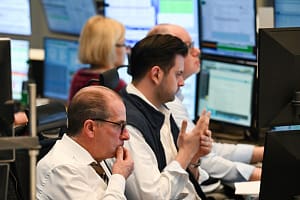U.S. equities ended the holiday‑shortened week mixed. Mid‑cap and small‑cap indexes eked out gains, yet the Dow, S&P 500 and Nasdaq retreated as mega‑cap technology sagged.
Fresh U.S. limits on exporting advanced chips jolted AI leaders such as NVIDIA and AMD, deepening concern about the trade rift with China.
Sentiment cooled further after Federal Reserve Chair Jerome Powell said recent tariff increases were “significantly larger than anticipated” and likely to lift inflation while slowing growth.
He added that policymakers can wait for clarity before adjusting rates, a stance interpreted as shelving near‑term cuts.
Housing data reinforced caution. The National Association of Home Builders index stayed below neutral at 50, and March housing starts declined 11 %, showing builders are wary.
Builder confidence lags as buyers struggle with affordability and shifting rules. Consumers, however, shopped ahead of a proposed 25 % auto tariff: retail sales rose 1.4 %, powered by a 5.3 % jump at car dealers and solid demand for building materials and electronics. Treasuries benefited from a mild flight to safety, nudging intermediate‑term yields lower. Intermediate maturities retraced part of the prior week’s sell‑off. Year‑to‑date, major benchmarks sit 8 % to 16 % beneath early‑January highs overall.
European market overview
European equities regained ground, buoyed by a calmer trade backdrop and fresh monetary support. The STOXX Europe 600 rose almost 4 % on the week, trimming April’s earlier losses. Italy’s FTSE MIB led with nearly a 5 % gain, followed by Germany’s DAX, France’s CAC 40 and the UK’s FTSE 100.
Sentiment improved after President Trump delayed higher tariffs on European goods and the European Central Bank delivered another quarter‑point cut, taking its deposit rate to 2.25 %. The ECB dropped language hinting that policy was nearing neutral, and President Christine Lagarde reiterated a data‑dependent stance while signalling that rates may need to fall well below neutral to safeguard growth. Many economists now expect the deposit rate to approach 1.5 % by year‑end.
Incoming data supported the dovish turn. U.K. headline inflation slowed to 2.6 % in March—its smallest rise in almost three years—while payrolls recorded the steepest monthly drop since 2020 even as wage growth hovered near 6 %. Across the continent, policymakers warned that escalating trade tensions could further erode a fragile expansion, keeping easing expectations alive and underpinning equity gains. Lower borrowing costs have also encouraged investors back into cyclical sectors, helping banks and industrials outperform.
Asia‑Pacific highlights
Asia‑Pacific equities advanced as investors bet on policy support to offset trade shocks. Japan’s Nikkei 225 gained over 2 % after Tokyo and Washington reported tentative progress in bilateral negotiations. Expectations of softer U.S. tariffs lifted exporters, while a stronger yen near ¥142 and a drop in 10‑year yields to 1.31 % signalled demand for safe assets. Bank of Japan Governor Kazuo Ueda struck a cautious tone, hinting that further support could be warranted if external risks intensify.
On the mainland, China’s CSI 300 and Shanghai Composite also closed higher amid expectations of fiscal stimulus. First‑quarter GDP expanded 5.4 % year on year, beating forecasts, yet analysts noted the figure largely preceded this month’s U.S. tariff hikes. With duties on many Chinese goods now heading toward 145 %, several global banks have trimmed 2025 growth estimates. Beijing is widely expected to respond with infrastructure spending and targeted tax relief, details of which may emerge at the Communist Party Politburo meeting later in April.
The prospect of looser policy helped Hong Kong’s Hang Seng add more than 2 % and tempered worries about fading global demand. Sector‑wise, technology hardware, autos and materials outperformed as investors positioned for government support and potential currency gains.
Overall, the week saw U.S. tech softness balanced by European rate cuts and Asia‑Pacific stimulus hopes, highlighting that policy shifts and trade tensions remain the key forces steering global markets.






Leave a Comment